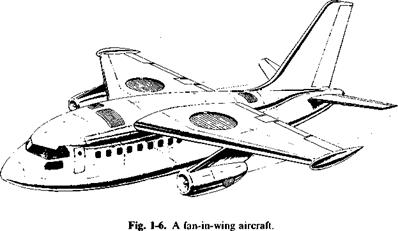Submerged Fans. Fan-in-Wing
In this configuration a large fan is submerged horizontally in the wing. In hovering the wing acts as a duct around the fan to improve its static thrust performance. In forward flight at low speeds the action of the fan is beneficial to the wing. An example of an aircraft incorporating this method of obtaining VTOL performances is illustrated in Fig. 1-6.
|
|
Direct Thrust
In this scheme separate jet engines are nested in the wing or fuselage to provide vertical thrust. Although the flow over the wing is affected to some extent by the engines, the effect is limited so that the characteristics of this type of VTOL or STOL aircraft can be approximated by determining the behavior of the wing and engines separately.
Aerodynes, Ducted Fans, and Highly Loaded Rotors without Fixed Lifting Surfaces
These types of STOL or VTOL aircraft employ highly loaded rotors to provide the lift and thrust for forward flight. Control is accomplished either by tilting the axis of the rotor or by deflecting its slipstream with a system of vanes submerged in the rotor slipstream. Vehicles of this type include the “flying jeep” and the “aerodyne” [6].
Thrust Augmentation
Somewhat similar to the jet pump, this configuration uses the primary flow from jets to induce a secondary flow. The static thrust available from a jet engine is therefore increased significantly by the entrained flow.
Tо summarize, many schemes have been proposed and are being studied for accomplishing STOL and VTOL aircraft.
1. Compound aircraft
2. Tail-sitters
3. Tilt-wing
4. Tilting-jets, ducted propellers or rotors
5. Deflected slipstream
6. Deflected jet
7. External flow, jet-augmented flaps
8. Boundary layer control
9. Circulation control
10. Submerged fans
11. Direct thrust
12. Aerodynes, ducted fans, and highly loaded rotors without fixed lifting surfaces
13. Thrust augmentation
These categories tend to overlap somewhat in their definitions. It is also possible that a V/STOL aircraft might incorporate several of these schemes to develop lift at low forward speed. For a more detailed description of many of these types of V/STOL aircraft, the reader is referred to Ref. 12.
Problems
1. An aircraft has a wing loading of 60 psf. If the approach speed is to be at least 20% higher than its stalling speed, what must the maximum lift coefficient be in order to land in 500 ft over a 50-ft obstacle as a matter of routine? Assume standard sea-level conditions.
2. An aircraft has propellers that can rotate to tilt the thrust vector upward. If we assume a constant thrust T and neglect the aircraft drag and ground-roll friction, would the shortest ground-roll distance to accelerate the aircraft to the stalling speed be obtained by keeping the thrust vector down so that the acceleration is a maximum or to tilt the thrust up through some angle в so that the required wing lift is diminished by the vertical component of the thrust?












